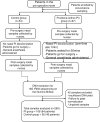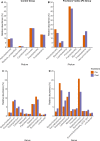A quality improvement study on the relationship between intranasal povidone-iodine and anesthesia and the nasal microbiota of surgery patients
- PMID: 36490265
- PMCID: PMC9733847
- DOI: 10.1371/journal.pone.0278699
A quality improvement study on the relationship between intranasal povidone-iodine and anesthesia and the nasal microbiota of surgery patients
Abstract
Introduction: The composition of the nasal microbiota in surgical patients in the context of general anesthesia and nasal povidone-iodine decolonization is unknown. The purpose of this quality improvement study was to determine: (i) if general anesthesia is associated with changes in the nasal microbiota of surgery patients and (ii) if preoperative intranasal povidone-iodine decolonization is associated with changes in the nasal microbiota of surgery patients.
Materials and methods: One hundred and fifty-one ambulatory patients presenting for surgery were enrolled in a quality improvement study by convenience sampling. Pre- and post-surgery nasal samples were collected from patients in the no intranasal decolonization group (control group, n = 54). Pre-decolonization nasal samples were collected from the preoperative intranasal povidone-iodine decolonization group (povidone-iodine group, n = 97). Intranasal povidone-iodine was administered immediately prior to surgery and continued for 20 minutes before patients proceeded for surgery. Post-nasal samples were then collected. General anesthesia was administered to both groups. DNA from the samples was extracted for 16S rRNA sequencing on an Illumina MiSeq.
Results: In the control group, there was no evidence of change in bacterial diversity between pre- and post-surgery samples. In the povidone-iodine group, nasal bacterial diversity was greater in post-surgery, relative to pre-surgery (Shannon's Diversity Index (P = 0.038), Chao's richness estimate (P = 0.02) and Inverse Simpson index (P = 0.027). Among all the genera, only the relative abundance of the genus Staphylococcus trended towards a decrease in patients after application (FDR adjusted P = 0.06). Abundant genera common to both povidone-iodine and control groups included Staphylococcus, Bradyrhizobium, Corynebacterium, Dolosigranulum, Lactobacillus, and Moraxella.
Conclusions: We found general anesthesia was not associated with changes in the nasal microbiota. Povidone-iodine treatment was associated with nasal microbial diversity and decreased abundance of Staphylococcus. Future studies should examine the nasal microbiota structure and function longitudinally in surgical patients receiving intranasal povidone-iodine.
Copyright: This is an open access article, free of all copyright, and may be freely reproduced, distributed, transmitted, modified, built upon, or otherwise used by anyone for any lawful purpose. The work is made available under the Creative Commons CC0 public domain dedication.
Conflict of interest statement
The authors have declared that no competing interests exist.
Figures




References
-
- Santacroce L, Charitos IA, Ballini A, Inchingolo F, Luperto P, De Nitto E, et al. The Human Respiratory System and its Microbiome at a Glimpse. Biology [Internet]. 2020;9. Available from: https://www.ncbi.nlm.nih.gov/pmc/articles/PMC7599718/. doi: 10.3390/biology9100318 - DOI - PMC - PubMed
MeSH terms
Substances
LinkOut - more resources
Full Text Sources

